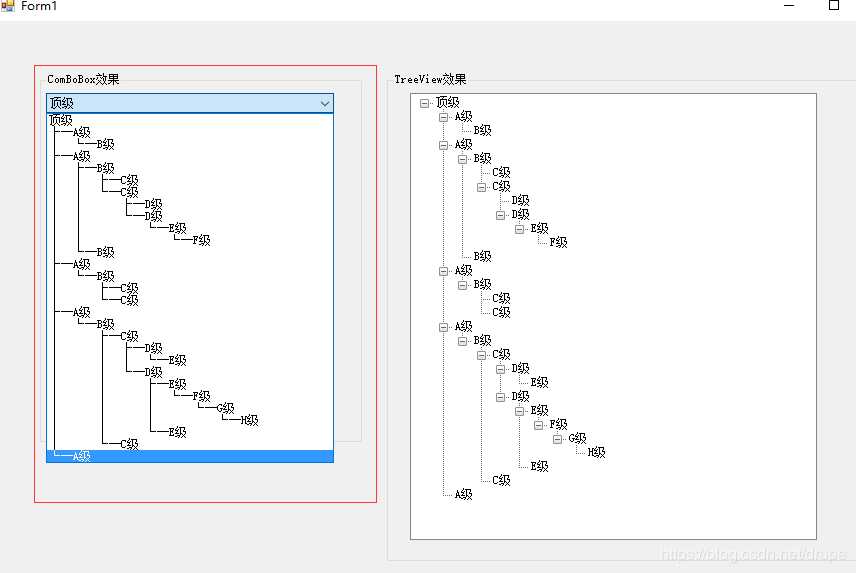C# ComboBox 下拉显示层次(树)
2021-01-21 13:13
标签:dash ict sele TreeView das array empty 一个 linq 数据库中很多时候用到树形结构,在界面上显示时如果是下拉框一次性显示时需要树结构来体现,看个效果图先: 主要是用算法补空格,补符号,源码如下: using System; ———————————————— 数据库中很多时候用到树形结构,在界面上显示时如果是下拉框一次性显示时需要树结构来体现,看个效果图先: C# ComboBox 下拉显示层次(树) 标签:dash ict sele TreeView das array empty 一个 linq 原文地址:https://www.cnblogs.com/ljs-13/p/12109171.html
using System.Collections;
using System.Collections.Generic;
using System.Linq;
using System.Windows.Forms;
namespace WindowsFormsApplication1 {
public partial class Form1 : Form {
public Form1() {
InitializeComponent();
}
private List
protected override void OnLoad(EventArgs e) {
base.OnLoad(e);
pList = new List
pList.AddRange(new profile[] {
new profile { Id = 1, parentId=0, value="A级"},
new profile { Id = 2, parentId=0, value="A级"},
new profile { Id = 3, parentId=0, value="A级"},
new profile { Id = 4, parentId=0, value="A级"},
new profile { Id = 5, parentId=0, value="A级"},
new profile { Id = 6, parentId=1, value="B级"},
new profile { Id = 7, parentId=2, value="B级"},
new profile { Id = 8, parentId=2, value="B级"},
new profile { Id = 9, parentId=4, value="B级"},
new profile { Id = 10, parentId=3, value="B级"},
new profile { Id = 11, parentId=7, value="C级"},
new profile { Id = 12, parentId=7, value="C级"},
new profile { Id = 13, parentId=9, value="C级"},
new profile { Id = 14, parentId=9, value="C级"},
new profile { Id = 15, parentId=10, value="C级"},
new profile { Id = 16, parentId=10, value="C级"},
new profile { Id = 17, parentId=13, value="D级"},
new profile { Id = 18, parentId=13, value="D级"},
new profile { Id = 19, parentId=12, value="D级"},
new profile { Id = 20, parentId=17, value="E级"},
new profile { Id = 21, parentId=18, value="E级"},
new profile { Id = 22, parentId=18, value="E级"},
new profile { Id = 23, parentId=21, value="F级"},
new profile { Id = 24, parentId=23, value="G级"},
new profile { Id = 25, parentId=24, value="H级"},
new profile { Id = 26, parentId=12, value="D级"},
new profile { Id = 27, parentId=26, value="E级"},
new profile { Id = 28, parentId=27, value="F级"},
});
//实例化一个根节点
profile rootRoot = new profile();
rootRoot.Id = 0;
rootRoot.parentId = 0;
rootRoot.name = "顶级";
AppendChildren(pList, rootRoot, 0);
List
getName(rootRoot, _name);
ArrayList list = new ArrayList();
for (int i = 0; i list.Add(new System.Collections.DictionaryEntry(i, _name[i]));
}
comboBox1.DataSource = list;
comboBox1.DisplayMember = "Value";
comboBox1.ValueMember = "Key";
//用treeView控件显示
var node = new TreeNode("顶级");
this.AddTree(node, 0);
this.treeView1.Nodes.Add(node);
return;
}
public void AddTree(TreeNode parentNode, int parentId) {
var selectedList = pList.FindAll(item => item.parentId == parentId);
foreach (var group in selectedList) {
var node = parentNode.Nodes.Add(group.Id.ToString(), group.value);
AddTree(node, group.Id);
}
}
private List
private void getName(profile p, List
//this.listBox1.Items.Add(string.Format("{0}-{1}", p.Id, p.parentId));
if (p == null) return;
var str = string.Empty;
for (var i = 1; i if (tag.Contains(i)) {
str += " ";
} else {
str += "│ ";
}
}
name.Add(string.Format("{0}{1}{2}", str, p.name, p.value, p.parentId, p.Id, p.level));
for (int i = 0; i if (tag[i] >= p.level) {
tag.Remove(tag[i]);
}
}
if (p.tag == 0) tag.Add(p.level);
if (p.profileList != null && p.profileList.Count > 0) {
foreach (profile x in p.profileList) {
getName(x, name);
}
}
}
public void AppendChildren(List
try {
count++;
var id = profile.Id;
var subItems = list.Where(ee => ee.parentId == id).ToList();
if (subItems.Count > 0) {
for (int i = 0; i if (i == subItems.Count - 1) {
subItems[i].name = string.Format("{0}{1}", "└--", "");
} else {
subItems[i].name = string.Format("{0}{1}", "├--", "");
}
subItems[i].level = count;
subItems[i].tag = i == subItems.Count - 1 ? 0 : 1;
}
profile.profileList = new List
profile.profileList.AddRange(subItems);
}
foreach (var subItem in subItems) {
AppendChildren(list, subItem, count);
}
} catch (Exception e) {
MessageBox.Show(e.Message);
}
}
}
public class profile {
public string fill { get; set; }
public int tag { get; set; }
public string name { get; set; }
public int Id { get; set; }
public int parentId { get; set; }
public string value { get; set; }
public int level { get; set; }
public List
}
版权声明:本文为CSDN博主「Mars-Huang」的原创文章,遵循 CC 4.0 BY-SA 版权协议,转载请附上原文出处链接及本声明。
原文链接:https://blog.csdn.net/drupe/article/details/100975071
主要是用算法补空格,补符号,源码如下:
using System;using System.Collections;using System.Collections.Generic;using System.Linq;using System.Windows.Forms; namespace WindowsFormsApplication1 { public partial class Form1 : Form { public Form1() { InitializeComponent(); } private List
————————————————版权声明:本文为CSDN博主「Mars-Huang」的原创文章,遵循 CC 4.0 BY-SA 版权协议,转载请附上原文出处链接及本声明。原文链接:https://blog.csdn.net/drupe/article/details/100975071
上一篇:C#递归加载树